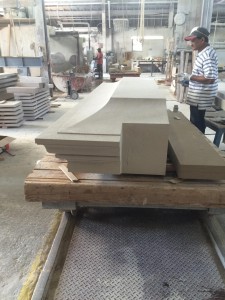About Petrillo Stone

At Petrillo Stone Corporation, we pride ourselves on attention to detail and the pursuit of perfection in everything we do. With every project we undertake, we strive for a finished product that is not just adequate, but as good as it could possibly be, and we take this attitude into each and every choice we make. And for every project, one of the first decisions we make regards the type of stone that we will use to best suit the client’s needs, preferences, and budget. At Petrillo, our experts search worldwide for the right stone for each unique job. From Finland and Zimbabwe to right next door in Connecticut and Indiana, we know that each client has specific designs in mind, and we are willing to go as far as is necessary to ensure we have the perfect stone to make those designs a reality. Whether it is granite, marble, limestone, or brownstone, the experts at Petrillo know which stone is needed for a given purpose or application, and will advise you on the best choice for your specific project.
In choosing the right stone, the experts here at Petrillo Stone Corporation will work with you to find the perfect combination of function and aesthetic for your specific needs and preferences. And once a stone is chosen, we’ll search worldwide to make sure the stone you get is exactly what you had in mind. After all, we strive for perfection in everything we do, and no project can be perfect without the perfect stone.
- Altar Restoration at Fordham University
- Gold Leafing on Comcast Building
- Marble Crucific in St. Pius X Church
More About Our Stonework

Calcatta Vagli Marble
As mentioned above, two of the most popular stones used in building and stonework today are marble and granite. Both are hard stones, visually attractive, and often used for countertops, flooring, and other household surfaces. However, both stones also offer their own individual ranges of benefits and drawbacks, depending on the exact way in which they will be used. Granite, for example, is the ideal choice for so-called “high-traffic,” areas, such as a work surface, because it harder than marble, and is also more resistant to the effects of acid and other substances. Granite also withstands the effects of weather significantly better than marble, and is thus better suited to outdoor applications such as walkways or patios. Marble, on the other hand, provides a number of aesthetic benefits, and is often considered the more visually appealing of the two. Its layered, veined appearance gives it a very natural look, while it is also more translucent, and reflects more light than granite. As such, it is often used in more decorative applications that receive less “wear and tear.” In either case, it is strongly recommended that both marble and granite be “sealed,” to prevent their soaking in water that eventually will both dull their appearance and weaken the stone.

Lugged Lintel Stone
Another stone type of stone especially popular in building, and becoming more so in recent years, is limestone. Known for centuries as a hard stone well suited for building, especially for floors, advancements in sealing technology have made limestone an even more attractive material over time. Because of its porous nature, limestone is subject to serious effects from water, smoke, and other substances that can enter the stone through its many pores. However, with the proper sealing, these effects can be avoided, and limestone can in fact be a very reliable and durable building material. In addition, this soft and porous quality make it much easier to cut and carve than other stones, making it an ideal choice for those seeking to create something very unique. Limestone also comes in a variety of shades and colorings, and is generally considered to maintain a very “elegant,” appearance, as seen in landmark buildings around America and the world. While it is relatively easy to quarry and can obtained fairly easily, it requires extreme skill and attention to be put in place properly, and thus can end up being a fairly expensive to install. One other interesting drawback is its intense reaction to acid rain, which can cause to erode and damage very quickly. This is worth considering in areas particularly prone to this occurring.
Two additional types of stone frequently used by Petrillo Stone Corporation are bluestone and brownstone. Brownstone, of course, is particularly well known for being the stone of choice for many of New York City’s older and more storied neighborhoods. While its inability to withstand significant weathering over time has caused it to be used less frequently for outdoor surfaces, it is still considered to be an attractive stone that can provide a “classic,” look inside a home. Bluestone, while sounding somewhat similar, is a more popular stone in today’s world, and is noted for its use in a variety of outdoor settings. Because of its high density and strength, bluestone, when properly sealed, can withstand any variety of weathering, including the freeze and thaw cycle that affects so many other stones. Its rough texture also makes it the perfect stone for many areas, such as around a pool, as it will not become slippery or dangerous even when wet.
For more information about our stonework and industry news, be sure to check out our blog.


